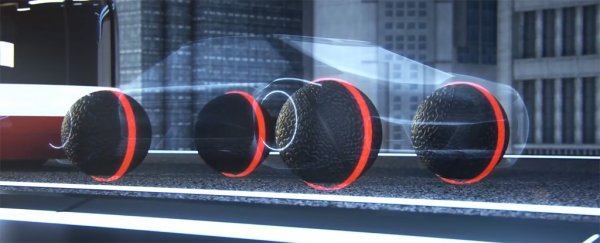With self-driving vehicles inching ever closer to reality, there are more than a few autonomous vehicle designs floating around. But we've never seen one quite like this.
Tyre giant Goodyear has shown off an ambitious wheel concept that offers a glimpse of what driving in the near future might look like. Doing away with the conventional wheel and axle setup, Goodyear envisages cars being carried by four spherical tyres, which can swivel their tread in 360 degrees to help the vehicle move in ways that today's cars never could.
Dubbed 'Eagle–360', the company says these multi-orientation tyres would provide superior manoeuvrability to today's mechanically aligned wheels, letting each tyre independently respond to potential hazards, such as ice on the road or sudden obstacles.
In theory, they could also provide a smoother ride, enabling the car to move sideways in instances like overtaking or lane changes, without requiring the nose of the vehicle to turn. Check out the video above and you'll get an idea of how that could work.
Goodyear says sensors in the tyre could monitor road and weather conditions – and communicate this to other nearby vehicles – in addition to keeping an eye on the quality of the rubber tread. With the tyres in theory being 3D-printed, Eagle–360 could be customised to the terrain that you usually drive in.
One of the most impressive features is the way these spherical tyres could help cars navigate in cramped spaces. Rather than being required to undergo a series of three-part-turns and back-and-forth shimmying to get into a tight parking space, spherical wheels that can move in any direction could let you just glide into any available spot without changing the orientation of the vehicle.
Provided the car can actually fit in a free spot, you wouldn't have to worry about any other geometry – although that might not be a problem in the cities of tomorrow anyhow.
That's all well and good, but how would it actually work? While Goodyear acknowledges that Eagle–360 is just a concept, and not a real product it's actually working on, the company says tyres like this would use magnetic levitation to do their thing.
In other words, the wheels wouldn't be mechanically connected to the rest of the vehicle, but instead the body of the car would be suspended above its wheels by magnetic force.
It sounds pretty sci-fi, but the same principle applies in maglev trains and hoverboards, so it could be doable for cars in the future too. We don't expect to see Eagle–360 rolling us around the neighbourhood any time soon, but it's an awesome idea that could make sense someday.
